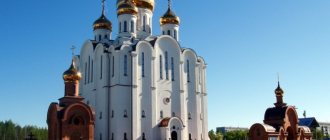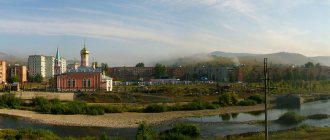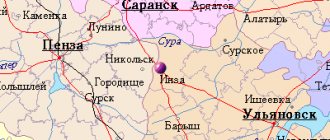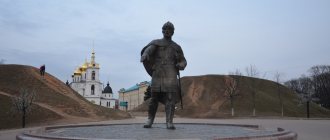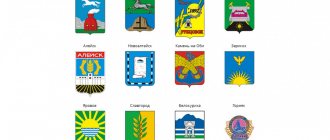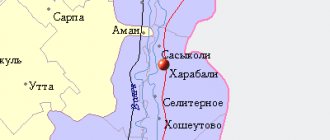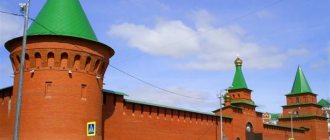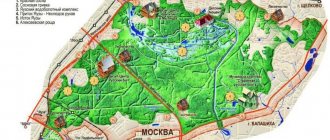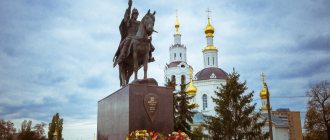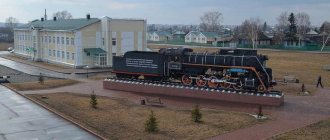The history of the city of Chita
Initially, Chita was called the Chita fort and was founded by Pyotr Beketov.
It was a village, but in 1821 it officially received city status. The city received its name from the Chita River, on the banks of which it was located. Previously, the main square was called Cathedral Square. But in the 20s it was renamed “Soviet Square”, and after a short period of time, “October Square”. The Decembrists occupied a large place in the development of Chita. It was for them that the Big Casemate was built. With the gradual arrival of the Decembrists, Cossacks and soldiers, the population doubled, and after some time expanded noticeably. Shops and houses began to be built, streets appeared. In 1900, the first railway was built through Chita, which became the largest in the Trans-Baikal Territory.
2. Until 1821, the fortified settlement from which modern Chita grew had the status of a fort, and the official date of birth of the city is 1887.
3. For the next 70 years of its history, the city of Chita did not flourish, although it managed to become the center of the Trans-Baikal region.
4.The impetus for its development was given by the construction of the Trans-Siberian Railway, which turned the town into an important logistics hub. Industry and trade began to develop here, and the population began to grow.
5. Chita is a well-maintained city. It looks very slender and beautiful, because the urban development plan was once created by real specialists.
6. The city is surrounded by incredibly beautiful nature, which many citizens come out to enjoy on weekends. In good weather, of course. After all, winter in these parts is long, cold and harsh. The actual winter in Chita lasts twice as long as the calendar one.
7. This is a multinational city, inhabited by representatives of various nations. Representatives of more than a hundred different nationalities live in Chita.
8. All three main Russian religions are widely represented here - Orthodoxy, Buddhism and Islam, but most of all followers of the first two.
9. The historical center of Chita has been well preserved to this day, and there is enough antiquity in it that can satisfy the curiosity of experienced tourists.
10. The city received its name in honor of the Chita River, on the banks of which it stands. It once bore other names - “Rafts”, “Rafts” and “Chitinskaya Sloboda”.
11. Geographically, the city of Chita is located almost in the very center of Transbaikalia.
12. In terms of population, Chita is not even included in the top 50 cities in Russia, but in terms of area it ranks 11th.
13. The area of Chita is 534 square kilometers. This is larger than the area of countries such as Andorra, Seychelles, Palau, Malta or Grenada.
14. The average annual air temperature in Chita is below 0 degrees.
15. One of the lakes in Chita is many millions of years old; it was formed back in the Pleistocene era. Previously, there were two such lakes here, but the second one dried up.
COAT OF ARMS OF CHITA
16. The coat of arms of Chita was approved 4 years before the revolution by Emperor Nicholas II. It was later changed, but in 1994 the old version was returned, approved by the last monarch of the Russian Empire.
17. During the times of the Russian Empire, this city was one of the places where convicts were exiled.
18. Pushkin’s poem “In the depths of the Siberian ores” is dedicated specifically to Chita.
19. After the Decembrist uprising, some of them were exiled to Chita. One of them even developed an urban development plan, using the plan of St. Petersburg as a basis.
20. Chita is the only large city whose districts have never been named after revolutionary themes. Leninsky, Kirovsky, Oktyabrsky and other districts exist in most cities, but not here.
MICHAYLO-ARKHANGELSKY TEMPLE - CHURCH OF THE DECEMBRISTS
21. The oldest building in the city is a monument of wooden architecture of federal significance, erected in 1776, when on the site of present-day Chita there was a small prison where the Decembrists served their exile. Divine services in the Archangel Michael Church lasted for a century and a half.
22.Soon after the revolution the church was closed, it fell into disrepair and gradually collapsed. The situation changed in 1971, after the building was transferred to the local history museum. After restoration, which lasted more than 10 years, museum exhibitions were placed within the walls of the former temple, telling about the life in exile of participants in the December uprising.
23. The initiator of assigning the status of the administrative center of the Transbaikal province to Chita was N. Muravyov-Amursky. The monument to the outstanding statesman, who for a long time was the Governor-General of Eastern Siberia, appeared in the city in the spring of 2014, immediately becoming one of the symbols of the capital of Transbaikalia.
24. A bronze sculpture weighing more than 2 tons is placed on a cylindrical 4-meter pedestal. Nikolai Nikolaevich, dressed in a ceremonial uniform, holds a scroll in one hand, and points to the flourishing city with the other hand.
25. There are 785 streets in Chita.
MEMORIAL OF MILITARY GLORY IN CHITA
26. A memorial dedicated to the military and labor feats of the residents of the Trans-Baikal Territory, accomplished during the Great Patriotic War, was solemnly opened in Chita on the 30th anniversary of the Victory.
27. Its dominant feature is a sculptural composition installed against the background of five steles, each 17.5 meters high, symbolizing the years of the war. Bronze sculptures depict three warriors rejoicing in the moment of victory.
28.The composition includes the Eternal Flame, pylons with the names of heroes who did not return from the front, and an arch. The alleys display examples of wartime equipment, including the SAU-100 and the legendary Katyusha rocket launcher.
THEATER SQUARE CHITA
29. One of the Chita streets has a very unusual name - Behind the goods yard. It was once called that because of its location, and the name stuck. The goods yard is long gone, but the street remains.
30. In the pre-revolutionary period, most buildings in Siberian cities, surrounded by forests, were traditionally built from the most accessible material - wood. Therefore, fires that caused serious damage were not uncommon in cities. To combat the natural disaster, fire stations with tall towers were built throughout the region. Chita was no exception.
FIRE TOOL IN CHITA
31. The building for firefighters was put into operation in 1907. Above it rises an elegant tower with an observation deck covered with an umbrella Buddhist dome. The exterior of the building attracts with the colorfulness of the rusticated brickwork, the elegance of the arcature belt, and proportionality.
32. 28 Chita streets are named after settlements in Transbaikalia.
33. Chita several times took first place in the anti-rating of Russian cities with the dirtiest air.
SZUMOVSKY PALACE
34. Shumovsky Palace - an incredibly beautiful building, which has been given the status of an architectural monument of federal significance, is rightly considered an architectural pearl not only of Chita, but also of the entire Transbaikalia.
35. It was built at the beginning of the last century for the millionaire Shumov brothers, who owned rich gold mines. The exterior of the palace is an example of a surprisingly harmonious combination of classicism and baroque. The facades of the mansion are decorated with elegant sculptures, openwork bay windows, elegant balconies, and delightful stucco moldings. Today the building houses the regional department of the FSB.
TITOVSKAYA SOPKA
36. Titovskaya Sopka is the main natural attraction, without which it is impossible to imagine Chita; it is, in fact, an extinct volcano, reaching a maximum height of 950 meters above sea level. People have settled on the slopes of the mountain since ancient times, as evidenced by numerous archaeological finds dating back to different eras, starting from the Stone Age.
37. There are several observation platforms here, from where you can enjoy amazing panoramic views. On some rocks you can still see ancient petroglyphs and rock paintings today. The chapel of Alexander Nevsky is considered the true decoration of the hill.
38. Since its founding, Chita has managed to be the capital of six administrative entities.
39. There is only one highway, one boulevard and three avenues.
40. All Chita buses and minibuses with the number “7” in their route number have their final stop in the village of Energetikov.
MONUMENT TO PETER BEKETOV
41. In Chita they had been planning for a long time to perpetuate the memory of the pioneer Peter Beketov, who devoted his life to exploring the lands of Siberia and the Far East, but things came to the real implementation of plans only at the beginning of this century.
42. The project of sculptor A. Mironov won the announced competition, and in October 2008 the monument was inaugurated. The statue of a Cossack centurion is cast from bronze. From behind Beketov, dressed in a caftan, the barrel of a gun can be seen. The impeccable posture of the Cossack demonstrates an iron will and unbending character.
43. Kazan Cathedral is the main Orthodox church of Chita. It was built in modern times and was consecrated in 2004. Its architecture displays features characteristic of churches in Vladimir or Suzdal. The five-domed cathedral with a hipped bell tower is elegant and majestic. The central dome of the church, weighing 25 tons, rises 47 meters, and the belfry has 13 bells of different sizes.
44.The façade of the building is decorated with arcature belts and zakomaras. The pearl of the temple’s interior is the luxurious carved iconostasis, covered with gilding. The cathedral houses a revered shrine - the reliquary with the relics of St. Barlaam of Chikoy.
APARTMENT HOUSE OF M. BERGUT
45. The apartment building of M. Bergut stands out among the historical buildings, of which there are many preserved in Chita. This mansion, commissioned by M. Bergut at the beginning of the last century, stands out precisely for its eclectic architecture.
46.In its exterior there was a place for rustication, characteristic of the Russian style, openwork baroque attics, and windows recessed into niches. At the same time, the outlines and features of the building’s layout evoke thoughts of classicism. Everything combines surprisingly harmoniously, so the mansion looks great.
47. Due to the sharply continental climate, it can be very hot here in summer and very cold in winter. The records are +43.2 and -49.6 degrees, respectively.
48. Having visited the Transbaikal Museum of Local Lore, you can learn an incredible amount of interesting things about Transbaikalia, Siberia and the Far East. The exhibition is divided into several sections dedicated to flora and fauna, as well as various historical eras.
49. Among the exhibits there are many unique artifacts found by archaeological expeditions. Among other things, visitors will admire the magnificent collections of Chinese porcelain, jewelry, awards and coins, and original Japanese painting.
50. Seasonal temperature changes here exceed 90 degrees. In winter it can be below -50 (fortunately, this happens very rarely), and in summer it can briefly reach +40.
photo from the Internet
Sights of the city of Chita
The city is famous for its sights, which preserve a long history.
The monument to love and fidelity was opened on July 8, 2011, on Family Day. A monument was erected at the intersection of Stolyarova and Amurskaya streets. The place for the sculpture was not chosen by chance. It was at the intersection of these streets that the wives of the Decembrists lived. The author of the monument is M. Albatasov. The sculpture represents a man and a woman who met after a long separation. The botanical garden was founded in 1990. It surprises with its huge exposition. All climatic conditions have been created for plants. The garden area is 27 hectares.
The zoo was opened on July 20, 1994. At that time there already existed a small zoo where roe deer, goats, peacocks and swans lived. These animals first appeared in Chita in 1986. By the time the large zoo opened, about 200 individuals had been collected. Some animals were picked up wounded in the forest, and some were taken from poachers.
The Alexander Nevsky Chapel was equipped in September 2001. Construction of the chapel lasted only a few months. The place for its construction was not chosen by chance; in 1891, Chita was visited by Tsarevich Nikolai Alexandrovich, who visited Titovskaya Sopka.
Chita Datsan is a Buryat Buddhist monastery located in Russia. It was opened in 2010, although the site for its construction was illuminated back in 2001.
The Kazan Cathedral is the main one in Chita. This temple is the decoration of the city. On June 21, 2002, the first liturgy was held in the church in honor of the Kazan Icon of the Mother of God.
Trans-Baikal Regional Museum of Local Lore named after. A.K. Kuznetsova
Trans-Baikal Regional Museum of Local Lore named after A.K...
Chita
Transbaikal Museum named after. A.K. Kuznetsov is one of the oldest local history museums in Siberia and the Far East. It was opened in 1895. The museum collection includes more than 190 thousand exhibits - the same number is stored in the Tretyakov Gallery in Moscow. Here you can see rare archaeological and ethnographic finds. They talk about the indigenous inhabitants of Transbaikalia: Mongols, Evenks, Cossacks - their economic way of life and religion. The fund also includes a rich collection of numismatics: commemorative medals, orders and badges, tokens and coins.
The museum contains manuscripts of famous public figures of Transbaikalia in the 19th and 20th centuries and the Decembrists, who served hard labor in the Chita volost from 1827 to 1830. You can meet some of them in the former Old Chita Church of St. Michael the Archangel - the oldest building in Chita, which was built in 1776.
Today it houses a branch of the local history museum - the Museum of the Decembrists. Its exhibition included books that belonged to the exiles, lifetime editions of their works and personal belongings: Nikolai Bestuzhev’s watch, Maria Volkonskaya’s box, Mikhail Bestuzhev’s table.
Flag
The flag of Chita is a rectangular panel divided into four elements. The ratio of the width of the flag to its length is 2:3. In the pole part of the flag there is a yellow triangle, adjacent to which are equal-sized horizontal stripes of green, white and red. Where yellow (gold) is a symbol of wealth and justice; red (scarlet) – a symbol of courage, bravery and fearlessness; green is a symbol of hope, joy and abundance; white (silver) is a symbol of purity, perfection and independence.
Chita Synagogue
Chita Synagogue
Transbaikal region
The first Chita synagogue was built back in 1880. It was a small wooden building that quickly fell into disrepair. Soon the old-time Jews decided to build a new stone synagogue. In 1903, local architect Gavriil Nikitin began to think through the project, but the final version was developed by his colleague Rodyukov. Construction of the synagogue began four years later. In place of the old wooden building, a stone three-story building in the eclectic style appeared.
In 1919–1922, many Jewish families moved from Chita to the Chinese city of Harbin. In 1930, the building was handed over to refugees from the south of the Chita region. Later, a forestry technical school and a bank were located here, and during the Great Patriotic War there was an evacuation hospital.
At the end of 1998, the Jewish community began to revive in Transbaikalia. Four years later they registered the Chita parish, which was allocated three synagogue rooms.
Today the Chita community is one of the largest in eastern Russia. The synagogue runs a Sunday school, where children learn Hebrew and get acquainted with national traditions. On the ground floor of the building, religious holidays are celebrated and performances are staged on themes from the Torah.
Transbaikal Regional Drama Theater
Transbaikal Regional Drama Theater
Chita
The Chita Drama Theater appeared in the 1920s, when the troupe of the Samara Theater of Working Youth came to the city. After the next tour, the artists remained to work in Chita. They were housed in a building that was built by architect Fyodor Ponomarev back in 1911. The first performance took place in November 1939 based on the play by playwright Nikolai Pogodin “The Aristocrats”.
During the Great Patriotic War, drama theater artists gave performances in hospitals and military units. Among the productions of these years are “The Guy from Our City” by Konstantin Simonov, “Nadezhda Durova” by Konstantin Lipskerov and Alexander Kochetkov and others.
In 1971, the theater moved to a new building with a glass “curtain” facade, where it is still located. In the 1980s, directors Alexander Slavutsky and Efim Zolotarev worked here. The theater's repertoire consists of works of Russian and foreign classics, as well as modern playwrights of the 20th century - Alexander Vampilov, Grigory Gorin, Alexander Gelman and many others.
Transbaikal State Puppet Theater "Far Away Kingdom"
Transbaikal State Puppet Theater "Far Away...
Chita
The Far Away Kingdom Theater is the first and only puppet theater in the Trans-Baikal Territory. Its history began with a mobile theater that appeared in Chita in 1935. During the Great Patriotic War, artists as part of the propaganda brigade performed performances for wounded soldiers in hospitals.
The theater's repertoire includes more than 40 productions for audiences of different ages. Artists use several puppet systems: glove puppets, cane puppets, puppets and tablet puppets. Also in the "Far Far Away Kingdom" they work in the direction of baby theater, which shows performances for the youngest children - up to three years old.
Today, in the puppet theater, in addition to classical performances, you can see performances from the repertoire of the colorful Chinese shadow theater and the “cardboard theater.” In addition, the project “Grandmother's Tales” - tabletop puppet shows - was developed here.
